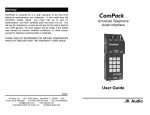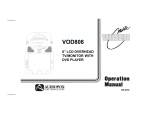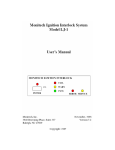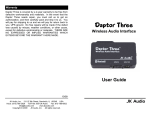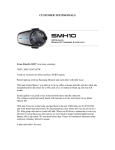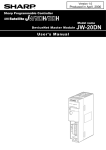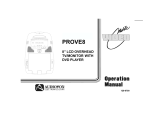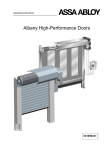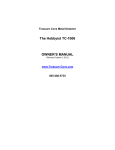Download RemoteMix 4
Transcript
Warranty RemoteMix 4 is covered by a two year warranty to be free from defective workmanship and materials. In the event that the RemoteMix 4 needs repair, you must call us to get an authorization, and then carefully pack and ship it to us. You will pay for shipping to us and we will pay for return back to you, UPS ground. No free repairs will be made if the defect was caused by misuse, weather conditions, or other cause, except for defective workmanship or materials. RemoteMix 4 Portable Broadcast Mixer THERE ARE NO EXPRESSED OR IMPLIED WARRANTIES WHICH EXTEND BEYOND THE WARRANTY HERE MADE. 12/07 JK Audio, Inc. 1311 E 6th Street, Sandwich, IL 60548 USA Voice: (815) 786-2929 Toll Free: 800-JK-Audio Fax: 815-786-8502 [email protected] www.jkaudio.com Copyright © 2007 JK Audio, Inc. All rights reserved. User Guide JK Audio Introduction RemoteMix 4 is a four channel field mixer combined with a four channel headphone amplifier. It includes a telephone line hybrid and keypad, as well as a universal PBX handset interface and a 2.5 mm wireless phone interface. All this comes in a tough, portable unit that's smaller than a lunch box. These parts were designed to work together and save setup time in the field. There is no need to send an engineer with patch cables. All the pieces work together in one reliable unit. RemoteMix 4 also connects to any Bluetooth* Wireless Technology enabled device. This “hands free” mode offers a mono, telephonebandwidth connection. RemoteMix 4 will connect to any Bluetooth enabled cell phone, or other device such as a notebook or portable that allows a stereo wireless headset connection. This stereo headset mode offers full audio bandwidth. Radio - RemoteMix 4 was designed for sports remotes. You can use it as a phone line hybrid, calling into your studio talk show hybrid. Or, use it as a front end mixer for your POTS, ISDN or IP codec. You can also use it with your laptop codec. FCC Registration (continued) notice isn't practical, you'll be notified as soon as possible. You'll be given the opportunity to correct the problem, and you'll be informed of your right to file a complaint with the FCC. Your telephone company may make changes in its facilities, equipment, operations or procedures that could affect the proper functioning of your JK Audio product. If such changes are planned, you'll be notified by your telephone company. FCC-A Part 15 Compliance This equipment has been tested and found to comply with the limits for a Class A digital device, pursuant to Part 15 of the FCC Rules. These limits are designed to provide reasonable protection against harmful interfer-ence when the equipment is operated in a commercial environment. This equipment generates, uses, and can radiate radio frequency energy and, if not installed and used in accordance with the instruction manual, may cause harmful interference to radio communications. Operation of this equipment in a residential area is likely to cause harmful interference in which case the user will be required to correct the interference at his/her own expense. TV - RemoteMix 4 gives you the ultimate phone connectivity with four IFB feeds. You can send and receive interview audio, and pull IFB out of any business phone system, or even from your cell phone. This is more than a field mixer, this is a shoot saver. Changes or modifications not expressly approved by JK Audio can void the user's authority to operate the equipment. Great Sound - A soft limiter prevents overdriving the phone line interfaces, while the mixer XLR output is pre-limiter (full range). Bass Boost adds some low end before sending the signal down the phone line. The 3.5 mm Send and Receive jacks are convenient for recording the show, or mixing in your MP3 player. This device has been tested and found to comply with the limits for a Class B digital device, pursuant to Part 15 of the FCC rules. These limits are designed to provide reasonable protection against harmful interference when the equipment is operated in a commercial environment. This equipment generates, uses and can radiate radio frequency energy and, if not installed and used in accordance with the instruction manual, may cause harmful interference to radio communication. Operation of this equipment in a residential area is likely to cause harmful interference, in which case the user will be required to correct the interference at his/her own expense. Power Smart Design - The phantom power generator only runs if any of the rear panel 48 V switches are set to “ON” to avoid any unnecessary drain on batteries. Low noise, low power ICs are used throughout to preserve battery life. The low noise 100-240 VAC desktop style power supply (included) overrides the battery power only when the supply is actually providing power. If the power goes out, the batteries automatically cut in. *The Bluetooth word mark and logos are owned by the Bluetooth SIG, Inc. and any use of such marks by JK Audio, Inc. is under license. Other trademarks and trade names are those of their respective owners. 2 FCC-B Part 15 Compliance Changes or modifications not expressly approved by JK Audio can void the user's authority to operate the equipment. Shielded interface cables and AC power cord, if any, must be used in order to comply with the emission limits. The internal antennas used for this mobile transmitter must not be colocated or operated in conjunction with any other antenna or transmitter. 19 FCC Registration Connection Your new JK Audio product has been registered with the Federal Communications Commission (FCC). This product complies with the standards in Part 68 of the FCC rules. 1. Mic inputs 1 and 2 are balanced XLR jacks with low-noise amplifiers. 1. Connection and use with the nationwide telephone network The FCC requires that you connect this telephone equipment to the national telephone network through a USOC RJ-11C modular telephone jack. This equipment may not be used with Party Line Service or Coin Telephone Lines. This equipment is hearing aid compatible. 2. Information for the telephone company Upon request from your local telephone company, you are required to provide the following information: a) The "line" to which you will connect the telephone equipment (that is, your telephone number), and 2. Mic inputs 3 and 4 are balanced XLR jacks with low-noise amplifiers. A mic/line selector switch adds a 40 dB pad for a line level balanced input. A switch on each of the 4 XLR mic inputs will provide 48 V phantom power. If inputs 3 or 4 are set to Line input, the 48 V will not be present at the XLR jack even if the switch is left on. 3. The stereo 3.5 mm line level input can be used instead of or in addition to the channel 4 XLR input. You can connect either a mono or stereo signal to this mini jack. If you use a stereo input, both channels will immediately be summed together. Then the audio from the mini jack and the XLR would be added together and treated as one mono signal on channel 4. 5 4 3 2 1 b) The telephone equipment's FCC registration number.This can be found on the bottom of your telephone equipment, and, c) The ringer equivalence number (REN) for this equipment. The REN is used to determine the quantity of devices which will be connected to the telephone line. Excessive RENs on the telephone line may result in the devices not ringing in response to an incoming call. In most, but not all areas, the sum of the RENs should not exceed 5.0. To be certain of the number of devices that may beconnected to the line, as determined by the total RENs, contact the local telephone company. 3. Repair Instructions If it is determined that your telephone equipment is malfunctioning, the FCC requires that it not be used and that it be unplugged from the modular outlet until the problem has been corrected. Repairs to this telephone equipment can only be made by the manufacturer or its authorized agents or by others who may be authorized by the FCC. For repair procedures, follow the instructions outlined under the warranty section of the manual. 4. Rights of the telephone company If telephone equipment is causing harm to the network, the telephone company may temporarily discontinue your telephone service. If possible, they'll notify you before they interrupt service. If advanced 18 6 4. The stereo 3.5 mm line level output can be connected to your mini disk or other recording device. The Master Output will be on the Left channel and the Receive mix from the phone line and/or Cue input will be on the Right channel. 5. The Master Output is a balanced XLR jack that contains the sum of all four input XLRs and the 3.5 mm input. This audio signal has a full 20 Hz to 20 kHz bandwidth. 6. Each of the four mono headphone jacks can be set to hear either a mix of local mic and line inputs or the return from the phone line which will include a lesser amount of your local mix. 3 Connection Specifications 1. Connect your audio equipment, microphones, cue input, and headphones to the input and output jacks on RemoteMix 4. Inputs: Microphones(4): 2. (a) Connect the jack marked "Phone Line" to any standard analog telephone line, or (b) Disconnect the handset on an existing telephone and plug the coily cord from the phone into the Universal Handset Interface jack on RemoteMix 4, or (c) Connect the Wireless Phone Interface jack to the headset jack on your cellular telephone using the supplied JK Audio interface cable. The 1/4” Wireless Interface jack also serves as a Cue Input that feeds the headphones. Connect any line level output here, such as the output from your personal audio player. This signal does not reach the XLR output but will be present on the right channel (return) of the stereo output. 3. Turn on the power switch, flip the "Phone Line" switch to "Dial/ Talk", flip the keypad switch to “On” (only if dialing with the RemoteMix 4 keypad) and dial your call. You are now ready to broadcast or record a telephone interview. OR Line Input: 3.5mm Stereo line input, 20k ohms (-10 dBu nom.) Headphone Cue In: 1/4" TRS, 20k ohms, -10 dBu nom. Outputs: Balanced Out: 2. (b) Handset jack 2. (c) Cell Phone single analog telephone line on PBX telephone. Set A-B-C switch for best audio. connection using wireless phone cable provided 4 Male XLR 50 ohms, +16 dBu max., 20 Hz - 20 kHz ± 1dB Line Out: 3.5mm Stereo line output, 100 ohms -10 dBu nom. Headphones(4): 1/4" Stereo TRS, 8 ohms, 1/3 watt per channel Phone Line Connector: RJ-11C Isolation: 1500 VAC Ringer: 0.5B REN Keypad: DTMF PBX Interface: RJ-22 PBX Handset interface simulates electret, dynamic, and carbon handset microphone types Wireless Phone: 36" cable provided, with 2.5mm, 3-conductor headset plug Power: 100-240 VAC, 50-60 Hz, 1.2 A external power supply -or- two 9 VDC batteries Size: 9.5" x 8" x 3" (24.1 x 20.3 x 7.6 cm) Weight: 3.8 lbs. (1.7 kg) OR 2. (a) Standard Female XLR 2k ohm, (-25 dBu nom.) Channels 3 & 4 have -40 dB Mic/Line pad switch Line = +4 dBu nom., +16 dBu max., 50k ohms 17 Block Diagram Operation X LR In put 1 X LR In put 2 X LR In put 3 X LR In put 4 Phantom Phantom Phantom Phantom 3 .5 mm line in put Phone Line The RemoteMix 4 has an RJ-11 jack that can be connected to any standard, single line analog telephone line. This jack should not be connected directly to digital PBX or ISDN phone systems. Mic / Lin e Mic / Lin e Handset Interface If you do not have access to an analog phone line or if the phone system is a digital or analog PBX, ISDN, or a key telephone system, you can use the built-in handset interface. Disconnect the telephone handset from the coily cord and plug the cord into the RemoteMix 4 Universal Handset Interface jack. Now select the handset type on the 3 position switch. Mast er L imiter Blueto oth Return Bass Boost LED Me ter Phone Line Hand set Jac k Phone Lin e Hybrid Universal Handset Inte rface DTMF Keypad Trial and error works faster than a chart of handset types, but this basic description may help. Switch Position A B C Handset Microphone Type Electret Dynamic Carbon When using the wireless interface, it is important to keep your wireless telephone 12” - 24” away from the RemoteMix 4 and any microphone or headphone cables. This will help prevent unwanted RF noise from entering the unit. Maste r Outpu t 3.5 m m stere o outp ut Headp hone 1 16 He adpho ne 2 He adpho ne 3 He adpho ne 4 Wireless Pho ne/ Cue Input RemoteMix 4 t Simplified Mi 4 Block Diagram H eadph one C ue Headset Emula tor R Wireless / Cellular Telephones RemoteMix 4 comes equipped with a cellular phone interface built in to the 1/4” Cue Input. This 1/4” wireless interface accepts a specially designed 1/4” to 2.5 mm cable provided with the unit. This interface works with any wireless phone that accepts standard third party headsets and earpieces. Some wireless phones have the standard 2.5 mm jack while others have proprietary jacks. Adapters to convert the proprietary jack to a standard 3-conductor 2.5 mm jack are available for most wireless telephones through their dealers, local electronic stores or many internet stores. 5 Features Notes Mic Level Controls Each of the four XLR inputs has a level control knob with a separate red Clip LED to indicate clipping on each channel. If you see more than an occasional flash of the Clip LED you should decrease the level for that channel. Master Level Control The Master control knob will set the overall level of the sum of all the mic and line inputs. The LED meter for the master audio level ranges from -30 dB to +3 dB. Headphone Controls Each of the four headphone outputs has a separate level control so each listener can adjust their audio level independently. The switch beside each control knob will set whether that channel will hear just a Mix of the mic and line inputs from the internal mixer or the Return audio from the phone line which will also contain some of the mic mix but at a lesser level. Warning! Long-term exposure to loud audio may cause hearing damage. It is best to avoid extreme volume when using headphones, especially for extended periods. Cue Control The Cue control adjusts the signal going to the headphones from the 1/4” Cue Input. When using the 1/4” Wireless Phone Interface, the Main Feed control adjusts the level of your own voice in the headphones while the Cue control adjusts the level of the person on the other side of the call in your headphones. You should keep in mind that your wireless telephone also has level control. If you are having level problems that cannot be corrected with the controls on the RemoteMix 4, try adjusting the level on the wireless telephone itself. 6 15 FAQs Features ? ! Bluetooth Wireless Technology This multi-function switch activates the Bluetooth Wireless Technology. The blue LED directly above this switch indicates when it is on. See pages 10-11 for more information. ? How can I tell how much battery life is remaining? The red “Power” LED functions as a battery life gauge that will gradually dim as the battery runs down. This red LED will go completely dark about a half hour before the unit shuts down. Keep in mind that the VU meter, Bluetooth, and clipping LEDs will remain bright until the unit stops functioning. Does the AC power supply charge the batteries? ! No. You may use rechargeable batteries, but you must remove and recharge the batteries outside of the RemoteMix 4. ? ! I've lost my power supply for my RemoteMix 4 unit. I have a power supply that fits from a different product. Can I use this instead? NO! Never use a power supply other than the one that was supplied by your manufacturer. Power supplies are available in either AC or DC output with many combinations of voltage and available current. Most consumer power supplies are not regulated. This could invariably damage your equipment, and also create a great deal of noise. All of our DC power supplies are low noise with 5% tolerance. Bass Boost With this switch turned on, the Master Output audio will be sent through the Bass Boost before being routed to the telephone circuits. Keypad ON / OFF This switch disables the DTMF keypad to prevent unwanted tones from being transmitted down the phone line during a broadcast. Ringer RemoteMix 4 does not have an audible ringer but there is a visual ring indicator that will flash for incoming calls. This red LED is located directly below the keypad. Phone Line Switch When using the RJ-11 analog phone jack, this switch acts as the switch-hook for the telephone line. The Hang Up position is the normal on-hook position when you are not using the line or you are waiting for a call. When you want to place a call, or when a call comes in, switch to the Dial / Talk position. Power This is the main power switch that turns the unit on. Whenever the power is turned on, the red LED above this switch will be lit. The green AC LED will be lit whenever a live AC power source is connected, even if the main power switch is off. Keypad The telephone keypad provides DTMF tone dialing. You may use the keypad at anytime during a call but keep in mind that both transmit and receive audio are muted during a keypress. Redial Press this button to instantly redial the last telephone number that was keyed in. 14 7 Features FAQs IFB If using the phone line or handset interface for an IFB feed, the balanced male XLR output may be used to feed an IFB earpiece or other device. If using the 1/4” cue input / wireless adapter jack for the telephone connection, the IFB feed must be taken from one of the 1/4” headphone jacks. This also applies if you are planning to record both sides of the conversation while using the 1/4” wireless adapter jack for the telephone connection. ? ! Why doesn't my RemoteMix 4 ring when a call comes in? The audible ringer found on some of our other RemoteMix units was replaced with a visual ring indicator on the RemoteMix 4. This red LED flashes when a call comes in. The Ring indicator is located directly below the keypad on the front of the unit. ? ! Will any cellular telephone work with RemoteMix 4? The wireless interface on the RemoteMix 4 works very well with most cellular telephones. However, some wireless telephones generate excessive RF noise which can be can be heard as a “chattering” or “motor boat” sound. The noise from these particular telephones will be unacceptable for most broadcast applications. Also, some wireless phones have the standard 2.5 mm headset jack while others have proprietary jacks. Adapters to convert the proprietary jack to a standard 3-conductor 2.5 mm jack are available for most wireless telephones through their dealers, local electronic stores or many internet stores. ? ! What kind of device can I connect to the Cue Input? Setting the switch for the dual-purpose 1/4” input to “Cue Input” will provide a standard line level input from another audio device, such as a portable radio. The audio signal will be sent to any of the four headphone outputs if that headphone switch is set to “Return”. This way, your announcers can listen for a cue from their radio station at the end of a station break. ? The cellular interface cable was left behind at our last event. Can I get a replacement at our local audio supply store? This is a custom made cable and is not wired the same as those that may be available at your local electronics store. Please contact your JK Audio dealer or our Customer Service department and ask for a CN045 replacement cable. Bluetooth Wireless Technology While the mono audio path is easy to follow on the block diagram shown on Page 16, the stereo audio path is slightly different. When in stereo mode, the left and right audio paths from the Bluetooth device are mixed together before reaching the Receive bus. This is a full bandwidth (20 Hz to 20 kHz) mono path, so you will hear the full audio signal, but it will be mixed to mono. The transmit path is a bit more creative. The left channel of the Bluetooth enabled stereo receive device will receive the mic mixer output with a bandwidth of 20 Hz to 17 kHz. The right channel will receive the Cue Input signal. Keep in mind that cell phones do not offer transmission of stereo audio signals. This stereo headset mode is typically “listen only” from music player portables. ! ? ! 8 The output from Mic 3 is very low but the other mics are fine. Check the position of the Mic/Line switch near Mic 3. This input as well as the Mic 4 input can be switched to accept a line level signal from a mixer or other equipment. If your microphone audio is too low, that switch may have been left in the “Line” position. 13 FAQs Features ? Power RemoteMix 4 is powered by two 9 volt alkaline batteries located on the side of the unit. The red Power LED on the front of the device will gradually dim as the battery runs down, then extinguish about a half hour before the unit shuts down. Since these two batteries are in separate drawers and wired in parallel, you can hot swap one battery at a time so you never lose power. ! ? ! ? ! ? ! Why do I keep getting an error message when I try to pair with my Bluetooth enabled cell phone? There is a difference between “Idle Mode” and “Pairing Mode”. The first time you make a connection with a new Bluetooth enabled device, you must be in Pairing Mode. Please read carefully through the instructions on Page 10 of this User Guide for detailed information. What is the range of the Bluetooth transmitter/receiver? The RemoteMix 4 will transmit and receive audio signals up to 25 feet from your Bluetooth device. Because transmitting signals over longer distances will require more power, you should keep the RemoteMix 4 as close as possible to your Bluetooth device to conserve battery power. How do I send full bandwidth stereo through my Bluetooth phone? RemoteMix 4 supports A2DP (Sink), Hands Free and Headset profiles with BlueCore 3-Multimedia technology. You will be able to send full bandwidth stereo audio through any cell phone that supports A2DP. How long will the batteries last in my RemoteMix 4? There are many variables that affect battery life, such as phantom power, the number of headphones, and the use of Bluetooth. All of our battery life tests included 4 headphones playing music at average listening levels. These tests use standard alkaline batteries. Lithium batteries can add 3 to 4 times the battery life, at 3 to 4 times the cost. The following numbers are from lab tests and may not represent your usage: It is important to replace both at the same time with identical batteries. If two fresh batteries are not available, it is better to run using only one good battery. Since the battery fixtures are wired in parallel, it does not matter which one gets the single battery. We also provide a high quality, regulated AC to DC adapter to power RemoteMix 4 when AC power is available. Simply plug it into the back of RemoteMix 4 and plug the transformer into a wall outlet. This is a switching power supply so you can connect to a 110 or 220 VAC power source. When the power connector is inserted into the jack, the batteries are bypassed. The AC adapter does not charge the batteries. If you lose power during your broadcast, the RemoteMix 4 automatically reverts to battery power so your broadcast will not be interrupted. Make sure you use only the supplied AC power adapter with the RemoteMix 4. Using any other adapter could damage the unit. WARNING! It is strongly recommended that this product be connected to an adequate surge protection device for the power line as well as the telephone line at all times. 7 hours of broadcast through a cell phone using Bluetooth Wireless Technology at a distance of 1 meter. 9 hours of broadcast through the phone line hybrid, using a phantom powered microphone. 10 hours of broadcast through the phone line hybrid, using dynamic microphones. 12 9 Connecting—Bluetooth Wireless Technology Connecting—Bluetooth Wireless Technology Establishing a Bluetooth connection varies with different cell phones. On your phone, find and select the option to set up a connection. Monitor the Bluetooth audio path on headphones in the "Return" position on the RemoteMix 4. Pull up on the Bluetooth multi-function switch on the front of the RemoteMix 4 and hold for approximately 5 seconds. You will hear a beep in your headphones, followed by a second beep or beeps. The blue LED will begin to flash rapidly as RemoteMix 4 enters Pairing Mode. Now go to your Bluetooth device and search for Bluetooth connections. If this is the first time you have paired with this device you will first need to select the option to add an audio device. Wait until the cell phone has found the new Bluetooth device. Select from the list the ID of "JKRM4xxx" where “xxx” corresponds to the last 3 digits of the unit’s serial number. Enter “Yes” when asked to “Bond” with this device. The pin is "0000". (Earlier units with serial numbers up through RM401124 use a unique pin of 4xxx) When bonding is completed, the blue LED will flash at a rate of 1 second on, 2 seconds off. Once RemoteMix 4 has been added to your cell phone, subsequent connections can be made more quickly from Idle Mode. There is a difference between “Pairing Mode” and “Idle Mode” on a Bluetooth device. The very first time you connect to a new device, you must be in Pairing Mode. When you hold the Bluetooth switch up, the blue LED will come on steady for a moment, then it will flash at a rate of 200 ms on and 200 ms off. This first stage is Idle Mode. If you continue to hold the switch up, the LED will flash rapidly, about every 100 ms. This is Pairing Mode. Once in pairing mode, any Bluetooth enabled device within range can pair with RemoteMix 4. After pairing is complete, the connection to that device is secure. Bluetooth LED pattern to initiate Bonding Initialize 2 sec off, 2 sec on Idle Mode 200 ms off, 200 ms on Pairing Mode 100 ms off, 100 ms on While all phones and portables are different, typically if you connect in cell phone hands free mode, you will have a mono duplex connection. If you connect to a music player, you will be in stereo mode. Consult your cell phone or portable device for more details. The Bluetooth interface will first attempt to connect in hands free mode to a cell phone, allowing 3.4 kHz telecom bandwidth. If this is not available, it will attempt to connect in wireless headset mode to any product that allows a Bluetooth wireless audio connection. The wireless headset mode offers 20 kHz audio bandwidth. To disconnect from the Bluetooth device, simply pull up on the Bluetooth multi-function switch and hold for 5 seconds. If left unused in Idle mode or if a live call is disconnected, the RemoteMix 4 will automatically disconnect Bluetooth in two minutes. Bluetooth LED pattern after Bonding Hold Bluetooth switch up > 5 sec to reach Pairing Mode the first time a new device is connected, > 2 sec thereafter to connect from Idle Mode Bonded 2 seconds off, 1 second on 10 11











